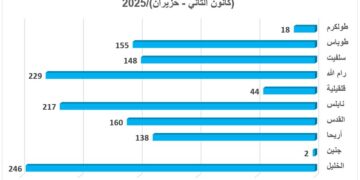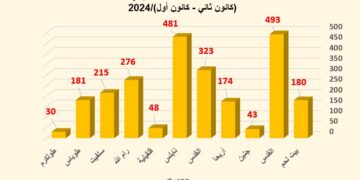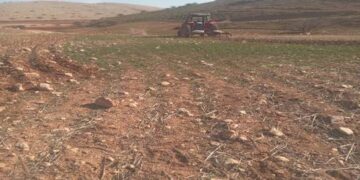The action of the illegal demolishing resulted in displacing ‘3’ people who resided the house, and the house furniture and family belongings where thrown out to the street just before the destruction of the house as reported by the owner. The owner also noted that the Israeli Army personnel deliberately destroyed and damaged in the process, vegetation on the surrounding sides of the targeted house.
According to the Israeli illegal redrawing of Jerusalem boundary in 1967, the targeted house is located within the illegal boundary of Israeli defined Jerusalem , were Palestinian has to go through complex procedures systemized by the Israeli municipality of Jerusalem to hinder Palestinians’ attempts to build on their lands.
Prior to the Israeli occupation of the West Bank territory in 1967, Beit Jala’s land amounted to 13340 dunums, of which it lost some 22% (3147 dunums) after the war and the Israeli illegal redraw of Jerusalem boundary. Much of the confiscated from Beit Jala toward Jerusalem today constitute the jurisdiction area of Gilo and Har Gilo settlements.
-
Gilo settlement was established in 1971 and has an area of 2738 Dunums, of which 1117 dunums were confiscated from the lands of Beit Jala. Today the settlement is inhabitant by more than 40000 Israeli settlers.
-
Har Gilo is the second Israeli settlement established on 314 dunums belonging to residents from Beit Jala. In 2007, Har Gilo had a total area of 420 dunums and a settler population of 414.
Further more the City of Beit-Jala and as all the other Palestinian occupied areas, was subject to the Israeli violation of more land confiscation by the year 2002. at that time the Israeli government led by PM Ariel Sharon declared the plan to build the ‘segregation wall’, another violation of international law that targeted the rights of native Palestinian population affecting the Beit-Jala village boundaries, a segment of 8 km length of the segregation wall that snakes through the lands of the city segregating 4,789 Dunums from the spaces of Beit-Jala, leaving the local native Palestinian population with the limited the space of 167 Dunums of the built up area. (See Map 1)
 Map 1: Beit-Jala Village boundaries with remark to house demolished and lands confiscation.
Map 1: Beit-Jala Village boundaries with remark to house demolished and lands confiscation.
All such previously mentioned Israeli illegal practices that were put in implementation by the consecutive Israeli governments, comes as a slam for the tremendous efforts invested by the international community to bring about a just end for the illegal Israeli long years of occupation. Israeli tools implemented of establishing the colonial settlement enterprise, and building the illegal Israeli segregation wall, all aims towards fortifying the policy of ‘facts of the ground’ run by the state of Israel.
ICRC have issued an explanatory interpretation note
on the matter of occupation and its space of permitted practices and exploitation of occupied territories at times of war, following are key noted interpretations that should be addressed when approaching the matter of the illegal Israeli exploitation of the Palestinian occupied territories:
‘The duties of the occupying power are spelled out primarily in the 1907 Hague Regulations (arts 42-56) and the Fourth Geneva Convention (GC IV, art. 27-34 and 47-78), as well as in certain provisions of Additional Protocol I and Customary international humanitarian law.
Agreements concluded between the occupying power and the local authorities cannot deprive the population of occupied territory of the protection afforded by international humanitarian law (GC IV, art. 47) and protected persons themselves can in no circumstances renounce their rights (GC IV, art. 8).
To conclude:
Israeli violations of IHL highlighted in its facts on the ground polices of house demolishing and the build illegal segregation wall accompanied by the expansions of the colonizing Israeli settlement enterprise, all form a policy of continuous braches of IHL, Israel and as an occupying power is obligated under IHL to maintain and preserve the main basic rights of the nation that came under it’s occupation.
::::::::::::::::::
[1] Occupation and international humanitarian law: questions and answers
A series of questions and answers by the ICRC’s legal team on what defines occupation, the laws that apply, how people are protected, and the ICRC’s role.
Prepared by

















